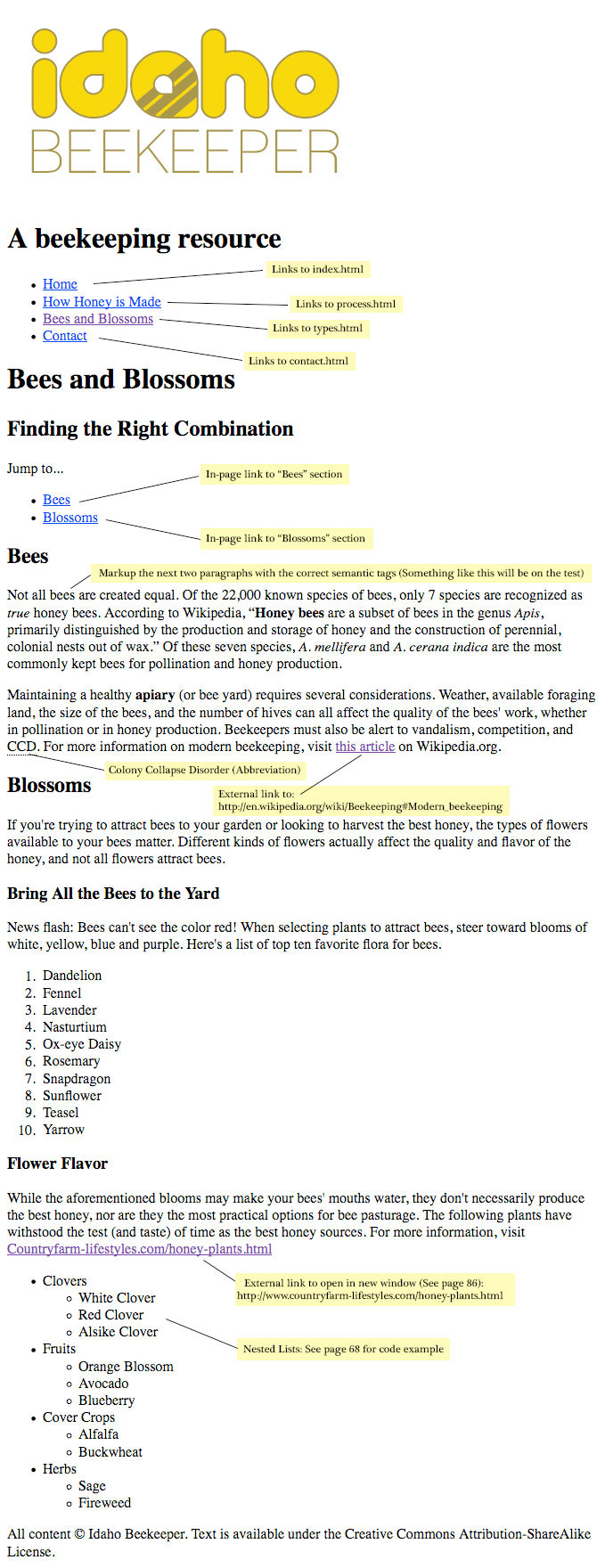Activity Due: Due Date #3
Both activities for this week will be due at this same time. Get started ASAP.
Instructions
- Copy and paste the code below into a new document in TextWrangler.
- Save this document as "types.html"
- View the Week 2 Day 2 Screenshot on this page. Use this screenshot to guide you through marking up the text (Right click and select "view image" to see a larger version of the screenshot).
- Add the text tags around the appropriate content (h1, h2, em, b, abbr, etc)
- Add list tags around the appropriate content (ul, li, etc)
- Add links to the appropriate content (a, href, _blank, etc).
The navigation links "How Honey is Made" and "Contact" do not exist yet. When these links are pressed a blank/error page will come up. This is normal, and is the design of this assignment. Create these links as if the corresponding pages did exist.
- Indent the nested tags
- Validate your document (http://validator.w3.org/)
- Upload this file to your practice folder on your website (yourWebsiteName.com/practice)
- Update the index.html file with the same navigation links (Home, How Honey is Made, Bees and Blossoms, Contact) from the types.html document you just created.
- Upload/update this file to your practice folder
types.html HTML code (copy & paste)
<!DOCTYPE html>
<html>
<head>
<title>Idaho Beekeeper | Bees and Blossoms</title>
<meta charset="utf-8"/>
</head>
<body>
<img src="https://310.commbyui.org/wp-content/uploads/2013/09/logo.png" alt="Idaho Beekeeper Logo"/>
A beekeeping resource
Home
How Honey is Made
Bees and Blossoms
Contact
<main>
Bees and Blossoms
Finding the Right Combination
Jump to...
Bees
Blossoms
<div id="bees">
Bees
Not all bees are created equal. Of the 22,000 known species of bees, only 7 species are recognized as true honey bees. According to Wikipedia, Honey bees are a subset of bees in the genus Apis, primarily distinguished by the production and storage of honey and the construction of perennial, colonial nests out of wax. Of these seven species, A. mellifera and A. cerana indica are the most commonly kept bees for pollination and honey production.
Maintaining a healthy apiary (or bee yard) requires several considerations. Weather, available foraging land, the size of the bees, and the number of hives can all affect the quality of the bees' work, whether in pollination or in honey production. Beekeepers must also be alert to vandalism, competition, and CCD. For more information on modern beekeeping, visit this article on Wikipedia.org.
</div>
<div id="blossoms">
Blossoms
If you're trying to attract bees to your garden or looking to harvest the best honey, the types of flowers available to your bees matter. Different kinds of flowers actually affect the quality and flavor of the honey, and not all flowers attract bees.
Bring All the Bees to the Yard
News flash: Bees can't see the color red! When selecting plants to attract bees, steer toward blooms of white, yellow, blue and purple. Here's a list of top ten favorite flora for bees.
Dandelion
Fennel
Lavender
Nasturtium
Ox-eye Daisy
Rosemary
Snapdragon
Sunflower
Teasel
Yarrow
Flower Flavor
While the aforementioned blooms may make your bees' mouths water, they don't necessarily produce the best honey, nor are they the most practical options for bee pasturage. The following plants have withstood the test (and taste) of time as the best honey sources. For more information, visit Countryfarm-lifestyles.com/honey-plants.html
Clovers
White Clover
Red Clover
Alsike Clover
Fruits
Orange Blossom
Avocado
Blueberry
Cover Crops
Alfalfa
Buckwheat
Herbs
Sage
Fireweed
</div>
</main>
All content © Idaho Beekeeper. Text is available under the Creative Commons Attribution-ShareAlike License.
</body>
</html>


Recent Comments